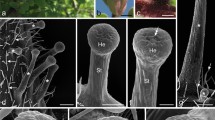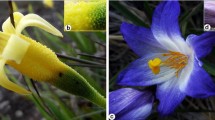Abstract
In some Apocynaceae a group of 10–15 resin glands is present as finger-like projections on the adaxial side of the proximal end of the petioles and sepals or petals. They originate from a group of epidermal and sub-epidermal cells. At maturity the glands are differentiated into a short stalk and a clavate head. The latter is composed of epidermal secretory cells and sub-epidermal parenchyma. Structurally and ontogenetically the resin glands resemble extrafloral nectaries and the standard colleters of the Rubiaceae. However, histochemical tests for lipophilic substances revealed that these glands secrete resin. The pale yellow, viscous secretion is released by cuticular bursting and covers the tender shoot apices and developing buds. The position and the secretory activity of the resin glands in relation to their function is discussed.
Similar content being viewed by others
References
Curtis J D and Lersten N R 1974 Morphology, seasonal variation and function of resin glands on buds and leaves ofPopulus deltoides (Salicaceae);Am. J. Bot. 61 835–845
Dave Y S and Patel N D 1975 A developmental study of extra-floral nectaries in slipper spurge (Pedilanthus tithymaloides, Euphorbiaceae);Am. J. Bot. 62 802–812
Dave Y S, Thomas V and Kuriachen P M 1987 Structure and development of colleters inAganosma caryophyllata G. Don.;Pak. J. Bot. 19 243–248
Dell B 1977 Distribution and function of resins and glandular hairs in Western Australian plants;J. R. Soc. West. Aust. 59 119–123
Dell B and McComb A J 1974 Resin production and glandular hairs inBeveria viscosa (Labill) Miq. (Euphorbiaceae);Aust. J. Bot. 22 195–210
Durkee L T, Baird C W and Cohen P F 1984 Light and electron microscopy of the resin glands ofPassiflora foetida (Passifloraceae);Am. J. Bot. 71 596–602
Gill A M and Tomlinson P B 1969 Studies on the growth of red mangrove (Rhizophora mangle L.) I. Habit and general morphology;Biotropica 1 1–9
Inamdar J A, Subramanian R B and Mohan J S S 1986 Studies on the resin glands ofAzadirachta indica A. Juss (Meliaceae);Ann. Bot. 58 425–429
Jensen W A 1962Botanical histochemistry, Principles and practice (San Francisco: W F Freeman)
Kay E L, Gutierrez R, Glymph E M and Nivert J J 1980 Guayule shrub deresination;Rubber Chem. Technol. 53 1273–1274
Lersten N R 1974a Morphology and distribution of colleters and crystals in relation to the taxonomy and bacterial leaf nodule symbiosis ofPsychotria (Rubiaceae);Am. J. Bot. 61 973–981
Lersten N R 1974b Colleter morphology inPavetta, Neorosea andTricalysia (Rubiaceae) and its relationship to the bacterial nodule symbiosis;Bot. J. Linn. Soc. 69 125–136
Lersten N R 1975 Colleter types in Rubiaceae, especially in relation to the bacterial leaf nodule symbiosis;Bot. J. Linn. Soc. 71 311–319
Lersten N R and Curtis J D 1974 Colleter anatomy in red mangroveRhizophora mangle (Rhizophoraceae);Can. J. Bot. 52 2277–2278
Levin D A 1973 The role of trichomes in plant defense;Q. Rev. Biol. 48 3–15
Metcalfe C R and Chalk L 1950Anatomy of dicotyledons vol. 2 (Oxford: Clarendon Press)
Miller I M, Scott A and Gardner I C 1983 The development, structure and function of dendroid colleters inPsychotria kirkii Hiern (Rubiaceae);Ann. Bot. 51 621–630
Mueller R J 1985 Determinate branch development inAlstonia scholaris (Apocynaceae). The Plagiotropic module;Am. J. Bot. 72 1435–1444
Murugan V and Inamdar J A 1987a Organographic distribution, structure and ontogeny of laticifers inPlumeria alba;Proc. Indian Acad. Sci. (Plant Sci.) 97 25–31
Murugan V and Inamdar J A 1987b Studies in the laticifers ofVallaris solanacea;Phytomorphology 87 209–214
O’Brien T P and McCully M E 1981The study of plant structure—Principles and selected methods (Melbourne: Termarcarphi Pty Ltd.)
Patel J D and Zaveri M 1975 Development of leaf and stipular glands inCoffea arabica;Flora 164 11–18
Ramayya N and Bahadur B 1968 Morphology of the ‘squamellae’ in the light of their ontogeny;Curr. Sci. 37 520–522
Spurr A R 1969 A low viscosity epoxy resin embedding medium for electron microscopy;J. Ultrastruct. Res. 26 31–43
Uphof J C T 1962 Plant hairs; inEncyclopedia of plant anatomy (eds) W Zimmermann and P G Ozenda (Berlin: Gebrilder/Borntrager)
Warming E 1883 Tropische Pragmente II.Rhizophora mangle L.;Bot. Jahrb. Syst. Pflanzengesch. Pflanzengeogr. 4 519–548
Williams R F, Metcalfe R A and Gust L W 1982 The genesis of form inOleander (Nerium oleander L.);Aust. J. Bot. 30 677–687
Author information
Authors and Affiliations
Rights and permissions
About this article
Cite this article
Subramanian, R.B., Murugan, V., Mohan, J.S.S. et al. Optical microscopic studies on the structure and secretion of resin glands in some Apocynaceae. Proc. Indian Acad. Sci. 99, 423–429 (1989). https://doi.org/10.1007/BF03053610
Received:
Revised:
Issue Date:
DOI: https://doi.org/10.1007/BF03053610




